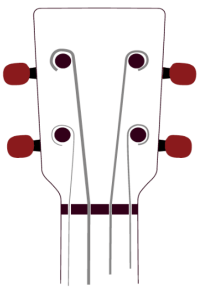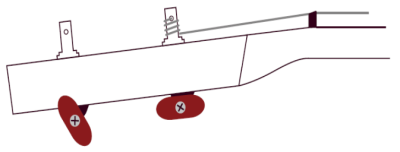string
A string is a thread made of natural (gut or silk), synthetic (nylon, fluorocarbon), or metallic (steel, brass) materials.
Fixed to a musical instrument, a string produces a sound when it is made vibrating by strumming or single-note picking. The pitch of this sound depends on the tension, the radius and the length of the string. The length of the strings is standardized in most stringed instruments (scale length). Quite frequently observed buzzing of strings is due to design or handling errors.
Images and Videos
Changing strings on an Ukulele with pin bridge
Please activate English subtitles!
Cordoba Demo Video
Harmonic division
Harmonic division
Unlike a piano, all the strings of the ukulele are equal in length. Therefore the rules of the harmonic division apply equally to all strings. When a string is beaten and begins to swing, the resulting length and speed of the waves on the string depend on where the string is held. An open string oscillates between nut and bridge in its entire length and thus moves the slowest. On the 12th fret, which marks half the length of the string, it oscillates twice as fast and high, producing a sound which is one octave higher than the open string. On the seventh fret, which marks about one-third of the string, a corresponding shortened oscillation (defined as a fifth) is produced on 2/3 of the total string, and on the 5th fret, the string is shortened to 3/4 (defined as a fourth).
Construction
Changing strings
Changing strings
Re-stringing your instrument is the best thing you can do for its tone; this often fixes apparent buzzing and intonation problems that have crept up as well. You should be putting on new strings about every 3 months.
Gordon and Char Mayer1)
- If several strings are to be replaced, this should be done individually and sequentially with all strings. To do this, turn the pegs of the 1st and 2nd string clockwise and of the 3rd and 4th strings counterclockwise to loosen the string tension.
* New strings should be wound up so that they are straight for as long as possible; they should therefore be threaded over the „inside“ of the pegs * The 1st and 2nd string pegs are turned clockwise, the 3rd and 4th strings pegs counterclockwise. * The wound ends should not be too long: two or three turns around the tuning peg are enough! * When wrapping, do not cross over. * As an aid for mounting on ukuleles with tuning machines, the use of a string winder is recommended.
Leveling
Leveling
New synthetic strings warp easily until they are leveled. To accelerate leveling, it is customary to stretch the strings vigorously (but sensitively) after pulling on and first tuning one after the other on the 12th fret by pressing, pulling the strings sidewards (bending) and retuning. This process is repeated several times.
Environmental Issues
Environmental Issues
Synthetic strings meet all the environmental concerns that are also raised against fishing lines of the same material. Fluorocarbons, unlike some polyamides, are virtually non-biodegradable by nature. According to scientific estimates, it takes 600 years for a synthetic fishing line to disintegrate.
Aquila
D'Addario
D'Addario
D'Addario makes ukulele strings from the following materials:
Clear Nylon
Warm, bright sound.
Black Nylon
Warm, soft sound. Recommended for Hawaii sound.
Nyltech
The material is Nyltech, developed by d'Addario in cooperation with Aquila.
Titanium
Brighter sound, louder.
D'Addario produces black strings for Kamaka which are distributed under the brand name Kamaka.
GHS
Orcas
Orcas
| Country | Colors | Character | Break in time5) |
|---|---|---|---|
 | black, transparent, red, lemon | warm, bright, balanced | 2-3 days |
Orcas, produced by Nihon Goraku, are considered a bit more high-end than Worth. The material is fluorocarbon. Strengths offered are easy, medium and hard for soprano and concert as well as a style for tenor, both in linear tuning and high G tunings.
Worth
Worth
⇒ Main article: Worth Creation Japan
| Country | Colors | Character | Break in time6) |
|---|---|---|---|
 | clear; brown | thinner than nylon or nylon; hard (brown: softer than clear); bright sound; permanently; good for solo playing; difficult for use with the pick | 1-2 days |
Made from fluorocarbon.
Recommmendations
Recommmendations
In practice, however, the question of which strings sound best on which ukulele can only be decided by trial and error.
Here are rough and completely non-binding rules of thumb:






